 |
| Pan de Cadiz, or Cadiz bread, above left, is marzipan rich with layers of sweetened egg yolk and sweetened yams; pasteles de yema, or yolk cakes, at right, are filled with the egg-yolk mixture. Above right, a wooden marzipan mold speaks clearly of the confection’s Andalusian traditions. |
Written and Photographed by Tor Eigeland
Leonardo da Vinci was angry.
“I have observed with pain,” he wrote, “that my signor Ludovico and his court gobble up all the sculptures I give them, right to the last morsel, and now I am determined to find other means that do not taste as good, so that my works may survive.”
His problem was that his sculptures were made of marzipan, which da Vinci valued for its malleability, but which his patrons admired for its edibility. In the service of Prince Ludovico Sforza of Milan, at Europe’s most splendid court, da Vinci used to create all kinds of marzipan figures that were meant to be permanent —but turned out not to be. The quotation above is from his Notes on Cuisine, written about 1470. Later, when da Vinci sculpted marzipan models of military fortifications at the behest of Lorenzo de’ Medici of Florence, the same thing happened: Teeth, not troops, overran his escarps and parapets.
 |
| Set in a bend of the Tagus River, Toledo is so filled with history that all of the central city has been declared a national monument. |
Da Vinci would have been angry with me, too. I find marzipan irresistible in any form: marzipan figurines, marzipan molded and painted to look like fruits and animals, chocolate-covered marzipan, marzipan filled with sweetened egg yolk and marzipan just about any way at all, at any time of year, morning, noon or night. This passion of mine started when I was a child in Norway and continued when I was a student in Mexico City. There, when I could afford it, I used to frequent the venerable shop of Mazapanes Toledo, named for the Spanish province and city where marzipan was invented. Thirty years later, my affections undimmed, I set out for Toledo, to see where it all began.
Seventy kilometers (43 miles) south of Madrid on the Tagus River, Toledo’s past reads like a résumé of the history of Spain itself. First settled by Celtiberians, it was conquered by the Romans, then the Visigoths. The Arabs disembarked on the southern coast of Spain in 711 and arrived in Toledo the following year, beginning their long and tolerant rule of the city they called Tulaytilah. Their tolerance was repaid, for when King Alfonso vi of Castile reconquered Toledo in 1085, he offered generous conditions to its citizens, thus continuing a highly civilized period of convivencia, when Arabs, Christians and Jews lived prosperously and harmoniously in the city. Today, Toledo is the home of magnif- icent historical monuments—and the world’s most expertly prepared, tasti- est marzipan.
 |
| An artisan begins to shape a marzipan bird, much as da Vinci may have done for his patrons. |
Other places claim to be the homeland of marzipan: Venice, Lübeck, Cyprus, Sicily and Baghdad. Most likely marzipan was not born in any of these places—although Baghdad may be the closest.
A clue to the origin of marzipan lies in its list of ingredients, which is short and simple: almonds and sugar.
Almonds, which originated in Central Asia, have been enjoyed for thousands of years. Through Persia, the Arab countries and North Africa, almonds arrived in Greece, Cyprus and Spain. In Greece, by the fourth century BC, ground almonds were mixed with honey to make a sort of precursor of marzipan, but this was not the real thing.
Traces of almonds have been found in Tutankhamen’s tomb, and in tombs at Baza, in the Spanish province of Granada, that date back to the fourth century BC.
Sugarcane originated on the Malay Peninsula and traveled to India sometime before the fifth century of our era, when we find the first description of sugar manufacture in the writings of the Buddhist scholar Buddhaghosa. The Persians had brought sugarcane to the valleys of the Euphrates and Tigris somewhat earlier, in the fourth century, and there produced and even refined sugar. The Arabs, after they conquered Persia in 640, gradually introduced the sweet reed to North Africa, Syria and Spain while perfecting the process of making sugar. And Christian Europe was introduced to sugar in Palestine in the 12th century, during the Crusades.
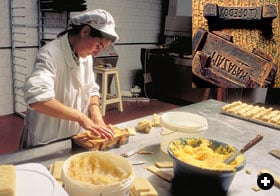 |
| To make pan de Cadiz, an artisan lines the mold with marzipan paste, adds a layer of sweet-potato “jam,” a rectangle of marzipan and a layer of yema de huevo con azucar, then finishes the loaf with more marzipan. Inset: This mold imprints a hallmark of quality: “Mazapan Toledo.” |
By 760—only 50 years after the Arabs arrived—tall, green sugarcane was swaying in the gentle Mediterranean breezes of the Motril and Málaga regions of Spain. The Arab settlers who planted it were expert farmers who developed sophisticated irrigation systems, some of which are still in use. In 1150, 30,000 hectares (74,000 acres) were dedicated to cane, and there were 14 sugar mills in the region of Granada alone. Wherever they went, in fact, the Arabs brought sugar.
Almond trees, first planted in Spain by colonizing Greeks, then by Phoenicians, were well established by the time the Arabs arrived. The Arabs brought many more, and when the trees blossomed each February, whole valleys looked as though they were covered in snow—an image Andalusian poets loved.
Spain was thus stocked with sugar and almonds, and with Arabs, who love good food and sweets. Knowledge wasn’t lacking either. The first references to marzipan in the Arab world date back to 700, and we can be sure that almond-based sweets such as marzipan arrived in Toledo with the Arabs at the beginning of the eighth century. By the 11th century, the mozárabes—Christians living under Muslim rule—wrote of getting together at Christmas to eat marzipan, apparently an established custom then and one that is very much alive today.
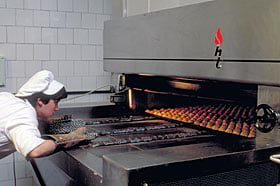 |
| Though ingredients, baking times and temperatures are firmly established, a good oven-tender keeps an eye on each emerging tray of pastas de almendra, or almond cakes, another form of marzipan. |
Some Spanish convents have claimed the invention of marzipan, but this overstates their role. What is true, as the learned Spaniard Gregorio Marañon (1887–1960) said, is that the closed religious orders preserved the craft of making marzipan through the thick and thin of history. Convents took up making sweets as a source of income, to survive, and continued using and perfecting their antique recipes through the centuries. Indeed, Marañon points out, sweets such as marzipan have become symbols of the complex heritage of the Spanish people.
There are dozens of theories about where we get the word marzipan. A traditional one, certainly erroneous, reaches back to the Latin marci panis, St. Mark’s bread, but in fact the word, like the product itself, is of Arab origin. My favorite derivation, and the one I find most likely, is explained by José Carlos Cabel in a book called Historia y Leyenda del Mazapan. The Arabs of Toledo, he says, called their paste of sweet almonds and sugar mawthaban, which supposedly means ‘seated king,’ for, before they were baked, the pieces of marzipan were stamped with a coin that showed a king seated on his throne. There was in fact a Byzantine coin, widely circulated in the Middle East by the year 1000, that showed a seated figure on the reverse, and which the Arabs called mawthaban.
 |
| An antique wooden mold showing Toledo’s historic Bisagra Gate and the city’s coat of arms. |
Another theory holds that the name comes from the Persian marzupan, which means “leader” or “chief,” or by extension “a person of quality.” The word was Arabized in Iraq, and today the famous sweet is known in Arabic as halwa al-marzuban, or—approximately—“the elite sweet.”
But did we get Spanish mazapan and German marzipan directly from the Arabic? Possibly not. The Venetians struck coins like the Byzantine ones about 1200 and called them mataban. And Sicilian and Neapolitan trading documents use the words martzapane and marzapane to refer to small, lightly built wooden boxes—like the ones in which such precious commodities as spices and confectionery were imported from the East. The word may have stretched to cover the contents of the boxes as well, giving rise to French massepain, English marchpane and Italian marzapane.
 |
| As they come from the oven, Eusebia Gallego Lumbreras, above, finishes almond cakes with a sugar-and-water glaze called jarabe—another word borrowed from Arabic. At Mazapanes Peces in Consuegra, 55 kilometers from Toledo, Carmen Casas, below, pipes intricate decorations of sweetened egg white onto an anguila, or eel, one of Toledo’s most elaborate traditional marzipan shapes. |
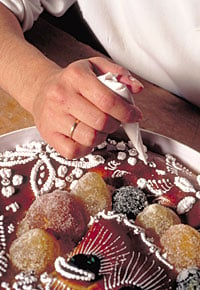 |
Marzipan consists simply of a half-and-half mixture of almonds and sugar, with slight variations. In fact, Spanish law requires that the “supreme quality” marzipan must contain at least 50 percent almonds. So where do quality differences come from? First, from the almonds: There are some 50 varieties of almonds in Spain alone, some more aromatic, others more flavorful. Next, from the trouble the maker takes, the degree of handwork he requires, and the extent to which he uses—or rather, avoids—preservatives. Almonds may be used raw by some makers, roasted, at various temperatures, by others; the almonds and sugar may be ground up to three times to make the fine, compact, dough-like mass desired. If the ingredients are ground too little, the marzipan will be coarse; too much, and the almond oil may separate out from the dough. Different kinds of sugar produce different results, and some makers soak the almonds in sugar syrup. There are infinite variations.
After the dough has been molded into a shape, perhaps filled with sweetened egg-yolk or other substances—sweetened yams (batata confitada) or a preserve made from pumpkin (cabello de angel) are traditional—it is baked in an oven at 220 to 230 degrees centigrade (425°–450°F), and then brushed with syrup to glaze it. A 24-hour cooling period at room temperature follows. Then, say the experts, the marzipan takes three days to reach its peak, and it remains at its best until the 15th day. From then on there is a slow deterioration in quality, although preservatives can keep a stale-almond flavor at bay for up to a month.
Highly mechanized operations work differently: Everything is faster, and quantities are vast. On the loading dock at the Delaviuda company in Sonseca, in Toledo province, about 25 tons of top-quality almonds, worth about $200,000, arrived in white sacks while I was standing there, just one of many deliveries. In 1994 Delaviuda produced 1077 tons of marzipan.
María Antonia Olivares, in charge of quality control at Delaviuda, showed me around their spotless plant. Despite all the machinery, it smelled deliciously of almonds, chocolate, and the other ingredients used to make different varieties of marzipan. Most of their products, she explained, are made according to traditional recipes, but some preservatives are added to extend shelf life. In spite of my prejudice against machine versus artisanal methods, I have to say that the Delaviuda products were absolutely exquisite—fit for kings.
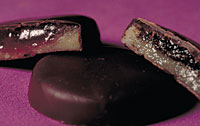 |
| Chocolate-covered discs of marzipan topped with fruit preserves are a modern invention. |
Delaviuda, besides being the largest of the many producers in Toledo province, has created a unique marzipan museum at the plant. Old prints and traditional implements show how Toledo marzipan was made through the centuries. There are wooden mallets for cracking almond shells, a granite mortar and a curved granite slab with a rolling pin for grinding the almonds, a hemispherical Moorish oven, and other tools of the trade so beautiful that they resemble sculptures.
Later, I set out looking for the finest handmade marzipan and, after some disappointments, found marzipan heaven. At Toledo’s famous Adolfo restaurant I sampled the handmade delicias of chef José Carlos Muñoz. Each day, Muñoz turns out about 100 of these delights—thick disks of wonderful marzipan buttered with blobs of sweetened egg yolk and folded into moist, soft half-moons that fairly explode with flavor. Of all the hundreds of varieties of marzipan, this is the best.
Muñoz starts his delicias with half marquona and half largueta almonds—the first for aroma and the second for flavor. Then he adds sugar weight for weight to the ground almonds. The shapes are baked on a wooden board, which helps retain their moisture. He uses no additives, so this marzipan remains in its optimum state for only four or five days.
I have eaten marzipan around the world for half a century, and to my taste, Toledo’s is by far the best. Most connoisseurs agree that Toledo is to marzipan what Gascony is to foie gras. And the few times that, on a missionary impulse, I have brought Toledo marzipan to northern Europeans—even to some from the German “marzipan capital,” Lübeck—they have regarded it as a culinary revelation. So what is the secret behind this unbeatable quality?
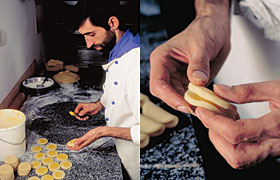 |
| Marzipan master José Carlos Muñoz, above, makes his yolk-filled delicias from specific varieties of almonds. Mazapanes Santo Tomé, below, has been a favorite of Toledo’s marzipan consumers since 1856. |
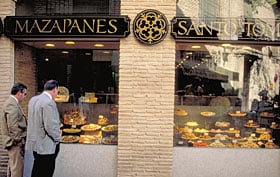 |
Even the city’s most famous confectioners do not seem to know. In fact, I found that most know very little about the long history of the product they make. Says Luis Moreno Nieto, chronicler of Toledo, “Is it the water? The air? The proportion of almonds and sugar? The purity of these products? The way of baking them? Nobody knows. Father Tagus, old and crafty, keeps the secret… as he runs and runs to the sea.”
But this is too poetic, contributing much to the city’s romance but little to knowledge. Yes, Toledo is beautiful, but the water is entirely ordinary, and the air is not special. The proportions of marzipan ingredients are fixed by law. Neither sugarcane nor almonds grow in this region of olives and grapes. And anyone can set a timer and the temperature of an oven!
What happened, I believe, was that the people of Toledo created a highly sophisticated and cultured—in fact, multicultured—city where people liked to eat well. Thus they started to bring in raw materials of quality, from other parts of Spain or farther still. They liked the marzipan they made so well that it became a point of civic pride among manufacturers to strive for nothing less than perfection.
By now they’ve been striving for more than a millennium. No wonder they’re the best.
 Photographer and writer Tor Eigeland has contributed to Aramco World and Saudi Aramco World for nearly 30 years, and has apparently passed on his fondness for marzipan to his daughter Natalie, right. Photographer and writer Tor Eigeland has contributed to Aramco World and Saudi Aramco World for nearly 30 years, and has apparently passed on his fondness for marzipan to his daughter Natalie, right. |